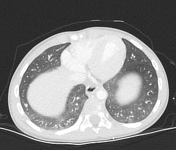Presentation
A child presents with a preceding viral illness developed a prolonged fever (>5 days), bilateral conjunctivitis, facial rash with cheilitis, and a desquamating rash of the palms and soles.
Patient Data









The coronary arteries arise from the expected coronary sinuses without coronary anomaly. However, there is fusiform dilatation of the proximal coronary arteries noted on both axial and coronal planes with measurements as followed:
left main coronary artery (axial, coronal) measuring 3 mm proximally and 7 mm distally (Z score 2.12-12.65)
proximal left anterior descending artery measuring 3 mm proximally and 5 mm distally (Z score 5.23-13.45)
proximal left circumflex artery measuring 5 mm proximally and 1 mm distally
proximal right coronary artery (axial, coronal) measuring 4 mm proximally and 2 mm distally (Z score 0.9-7.07)
There is an incidentally noted 4 mm nodular opacity in the peripheral right lower lobe which appears to be associated with a peripheral pulmonary arterial branch.
Case Discussion
The sequence of events (preceding viral illness) and clinical symptoms (fever with rash and conjunctivitis) are diagnostic of Kawasaki disease. As Kawasaki disease has a tendency to affect the coronary arteries, the images in this case demonstrate fusiform aneurysms of both the left and right main coronary arteries (left greater than right).
The incidentally noted pulmonary nodule noted on the lung window could represent a small peripheral pulmonary arterial aneurysm or pulmonary arteriovenous malformation. However, in the setting of sedation, a small focus of subsegmental atelectasis could also likely be the cause.
The patient was treated with anticoagulation (aspirin and low molecular weight heparin), intravenous immunoglobulin, and high-dose steroids. Following hospital discharge, the patient has been doing well, without any cardiovascular symptoms.
CO-AUTHORS:
Stacey Langford, MD
Camille Dumas, DO
Travis Bevington, MD




 Unable to process the form. Check for errors and try again.
Unable to process the form. Check for errors and try again.